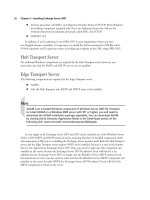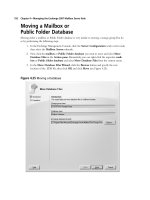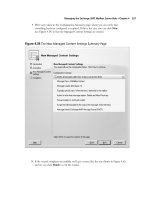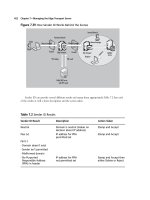Exchange SQL And IIS- P124 potx
Bạn đang xem bản rút gọn của tài liệu. Xem và tải ngay bản đầy đủ của tài liệu tại đây (314.13 KB, 5 trang )
592 Chapter 9 • Disaster Recovery with Exchange Server 2007
Now select the storage group that contains the database you wish to repair, click Next, and on
the Select Databases to Repair page, check the respective database, as I did in Figure 9.14. Then,
click Next.
Figure 9.13 Exchange Troubleshooting Assistant Tasks
Disaster Recovery with Exchange Server 2007 • Chapter 9 593
You will now need to read a repair task warning. I suggest you read it carefully. When you have
done so, choose Continue to Perform Repair Task, and then click OK in the confi rmation dialog
box shown in Figure 9.15.
Figure 9.14 Selecting the Database to Repair
Figure 9.15 ExTRA Confi rmation
594 Chapter 9 • Disaster Recovery with Exchange Server 2007
The tool will now run Eseutil /P and then Eseutil /D, followed by Isinteg –fi x –test alltests
against the respective database, just like we did manually earlier in this section. After a while,
depending on the size of the database, you will be taken to a Report Repair Results page where
you can see if the actions completed without any issues, and if not, it will show an explanation
why it didn’t.
Restoring Mailbox Data Using the
Recovery Storage Group Feature
The Recovery Storage Group (RSG) feature, which was originally introduced back in Exchange
2003, gives you, the Exchange administrator, the option of mounting a second copy of a mailbox
database (typically a mailbox database restored from backup) so you can extract data from one or
more mailboxes in the respective database during working hours without affecting the production
databases.
Depending on how much you have used the new Exchange 2007 Management Console (EMC),
you may have noticed you can no longer create an RSG from within the EMC. With Exchange
2007, this is instead done using the new Database Recovery Management tool, which as you saw in
the previous section, is found under the Exchange Toolbox work center, or by using the Exchange
Management Shell (EMS).
When mounting a copy of a Mailbox database to an RSG, you can extract the data
from a mailbox and then merge the data with another mailbox located in a mailbox database
in a production storage group. You can also extract the data and copy it to a specifi c folder in
another mailbox. With Exchange 2003 RTM, the data was extracted, copied, and merged
with another mailbox or mailbox folder using the Microsoft Exchange Server Mailbox Merge
Wizard (ExMerge) tool, but in Exchange 2003 SP1 the process was integrated into the Exchange
2003 System Manager GUI.
There are a few things you should be aware of when dealing with RSGs. First, they cannot be
accessed by any protocols other than MAPI, and although they can be accessed using MAPI, this
doesn’t mean you can connect to a mailbox stored in a recovery database using an Outlook MAPI
client. MAPI is strictly used to access mailboxes using the Exchange Troubleshooting Assistant and the
respective Exchange Management Shell cmdlets. In addition, you should be aware that you still
cannot use RSGs to restore Public Folder data, only mailbox data. It’s also worth mentioning that
even though you can create up to 50 storage groups on an Exchange 2007 Enterprise edition server,
you’re limited to one RSG per server. However, it’s supported to add multiple mailbox databases to
an RSG as long as all databases belong to the same storage group. Finally, you should note that
although it’s possible to add a restored mailbox database to an RSG on another Exchange 2007
server, it’s important you understand that the Exchange 2007 server must belong to the same Active
Directory forest.
With the preceding in mind, let’s move on and see how you manage RSGs.
Disaster Recovery with Exchange Server 2007 • Chapter 9 595
Managing Recovery Storage Groups Using
the Exchange Troubleshooting Assistant
You can create a Recovery Storage Group (RSG) either by using the Disaster Recovery Management
tool, which is based on the Microsoft Exchange Troubleshooting Assistant (ExTRA), or by running
the New-StorageGroup cmdlet with the –Recovery parameter in the Exchange Management Shell.
To create the RSG using the Disaster Recovery Management tool, you should fi rst launch it
from beneath the Toolbox work center in the navigation tree of the Exchange Management Console
(EMC). Let the tool check for any tool or confi guration fi le updates available, and then click the Go
to Welcome screen link. Enter an identifying label for this activity (such as Create RSG), and then
click Next. In the Tasks list that appears, click Create a Recovery Storage Group, and then select
the storage group you want to link with the recovery storage group, as shown in Figure 9.16. Then,
click Next once again.
Figure 9.16 Selecting the Storage Group to Link with the RSG
596 Chapter 9 • Disaster Recovery with Exchange Server 2007
After a little while, you will be presented with a screen similar to the one in Figure 9.18, and the
RSG for the respective Mailbox database has now been created.
Figure 9.17 Creating the RSG
Now it’s time to create the RSG, but before doing so you need to give it a name (the default
name is Recovery Storage Group, which should be okay in most situations). When you have entered
an appropriate name, click Create the recovery storage group (Figure 9.17).









